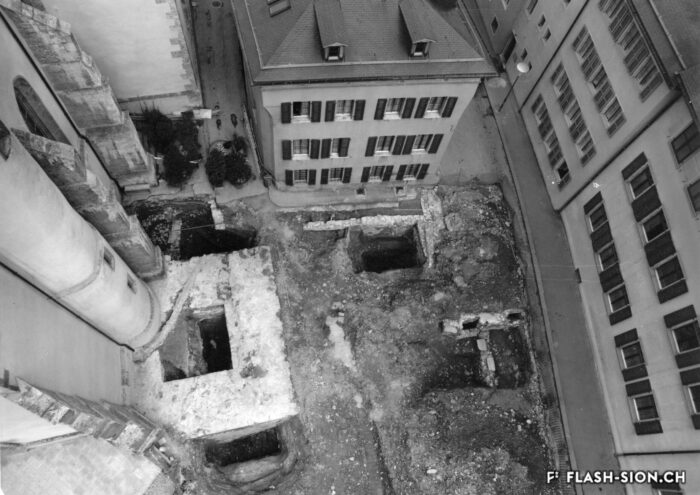Du culte du corps aux lieux de culte
Les fouilles archéologiques de St-Théodule au début des années 1960 révèlent une surprise de taille ! Sous l’église gothique actuelle, œuvre de reconstruction inachevée de l’illustre maître-maçon transalpin Ulrich Ruffiner, les archéologues découvrent non seulement les ruines de trois édifices religieux antérieurs, mais également les vestiges de thermes romains. Infrastructure balnéaire caractéristique de la vie sociale de la Rome antique, les thermes publics étaient placés à côté du forum. Ainsi, l’hypothèse de la présence d’une place publique au Glarier sous l’Empire romain est aujourd’hui avancée par les spécialistes.
Vom Köperkult zum Kultort
Die archäologischen Ausgrabungen von St.Theodul Anfang der 1960er Jahre hielten eine grosse Überraschung bereit! Unter den Mauern der bestehenden gotischen Kirche, die auf ein unvollendetes Projekt des berühmten Maurermeisters Ulrich Ruffiner zurückführt, entdeckten Archäologen nicht nur die Ruinen von drei früheren Sakralbauten, sondern auch Überreste einer römischen Therme. Die für das gesellschaftliche Leben im alten Rom charakteristische Badeinfrastruktur befand sich gewöhnlich neben dem Forum. So vertreten Wissenschaftler heute die Hypothese, dass während des römischen Reichs das Zentrum der Siedlung in Glarier gelegen haben könnte.
Cleanliness is next to godliness
The archaeological excavations at the church of St. Theodulus in the early 1960s uncovered a major surprise! Beneath the present-day Gothic church (an unfinished reconstruction by the renowned Italian master mason Ulrich Ruffiner), the archaeologists discovered not only the ruins of three earlier religious buildings, but also the remains of Roman baths. The public baths were a typical feature of social life in ancient Rome, and they were usually located beside the forum. This discovery has now prompted experts to suggest that there was a public square in Sion’s Glarier district under the Roman Empire.
Dal culto del corpo ai luoghi di culto
Gli scavi archeologici presso St-Théodule, all’inizio degli anni 60, svelano una sorpresa notevole! Sotto la chiesa gotica attuale, opera di ricostruzione incompiuta dell’illustre capomastro transalpino Ulrich Ruffiner, gli archeologi scoprono non solamente le rovine di tre edifici religiosi antecedenti ma anche vestigi di terme romane. Infrastruttura balneare caratteristica della vita sociale della Roma antica, le terme pubbliche erano collocate accanto al foro. Pertanto, oggi gli specialisti avanzano l’ipotesi della presenza di una piazza pubblica al Glarier sotto l’Impero Romano.







